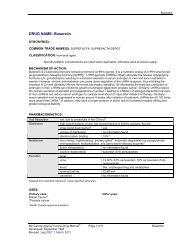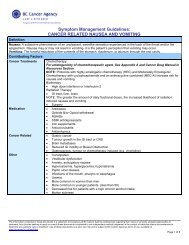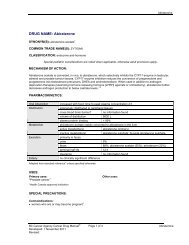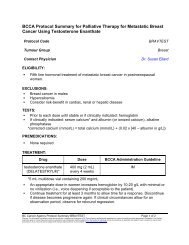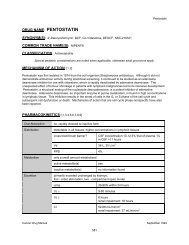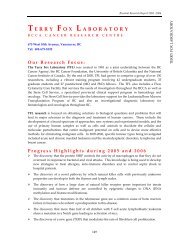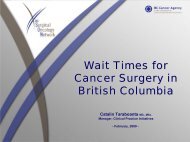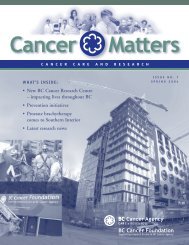DRUG NAME: Everolimus - BC Cancer Agency
DRUG NAME: Everolimus - BC Cancer Agency
DRUG NAME: Everolimus - BC Cancer Agency
Create successful ePaper yourself
Turn your PDF publications into a flip-book with our unique Google optimized e-Paper software.
<strong>Everolimus</strong><br />
<strong>DRUG</strong> <strong>NAME</strong>: <strong>Everolimus</strong><br />
SYNONYM(S): 40-O-(2-Hydroxy)ethyl-rapamycin, 1 RAD001 2<br />
COMMON TRADE <strong>NAME</strong>(S): AFINITOR®<br />
CLASSIFICATION: miscellaneous<br />
Special pediatric considerations are noted when applicable, otherwise adult provisions apply.<br />
MECHANISM OF ACTION:<br />
<strong>Everolimus</strong> is an inhibitor of mTORC1 (mammalian target of rapamycin complex 1). This complex plays an essential<br />
role in protein synthesis downstream of the P13K/AKT pathway, which is dysregulated in many human cancers.<br />
<strong>Everolimus</strong> has been shown to reduce cell proliferation, glycolysis, and angiogenesis in solid tumours in vivo. 1<br />
<strong>Everolimus</strong> is cell cycle phase-specific. It inhibits cell proliferation by blocking cell cycle progression from the G1<br />
phase to the S phase. 1-3 <strong>Everolimus</strong> is an immunosuppressive agent. 3<br />
PHARMACOKINETICS:<br />
Oral Absorption rapid 4 ; 30% bioavailability 4 ; high fat meals may reduce Cmax (60%) and AUC (16%)<br />
Distribution<br />
time to peak: 1-2 hours<br />
cross blood brain barrier? yes<br />
volume of distribution<br />
20% confined to plasma; tissue distribution not<br />
defined<br />
plasma protein binding 74%<br />
Metabolism<br />
extensively metabolized by CYP 3A4 4<br />
active metabolite(s)<br />
none<br />
inactive metabolite(s)<br />
6 main metabolites; three monohydroxylated<br />
metabolites, two hydrolytic ring-opened<br />
metabolites, and a phosphatidylcholine conjugate<br />
Excretion<br />
mainly biliary/fecal (as metabolites)<br />
urine 5%<br />
feces 80%<br />
terminal half life 4<br />
30 hours<br />
clearance<br />
5-55 L/h<br />
Ethnicity<br />
higher clearance in blacks<br />
Adapted from standard reference 3 unless specified otherwise.<br />
USES:<br />
Primary uses:<br />
* Renal cell carcinoma<br />
*Health Canada approved indication<br />
Other uses:<br />
<strong>BC</strong> <strong>Cancer</strong> <strong>Agency</strong> <strong>Cancer</strong> Drug Manual © Page 1 of 7 <strong>Everolimus</strong><br />
Developed: 01 November 2010<br />
Revised: 1 June 2013
<strong>Everolimus</strong><br />
SPECIAL PRECAUTIONS:<br />
Contraindications:<br />
history of hypersensitivity reaction to everolimus or other rapamycin derivatives (i.e., sirolimus, temsirolimus) 3,5<br />
Caution:<br />
immunosuppression induced by everolimus may predispose patients to bacterial, fungal, viral or protozoal<br />
infections, including infections with opportunistic pathogens. Hepatitis B reactivation has been reported. Preexisting<br />
infections should be treated and fully resolved before starting everolimus. 3<br />
vaccination may be less effective due to diminished immune response. 3 Live vaccines and close contact with<br />
individuals who have received live vaccines should be avoided to reduce the risk of infection from the vaccine. 3,6<br />
impaired wound healing is a class effect of the rapamycins. Exercise caution during the peri-surgical period. 3<br />
high potential for drug interactions due to CYP 3A4 or P-glycoprotein 3,7 ; see Drug Interactions section for more<br />
detail<br />
Carcinogenicity: not oncogenic in animal studies 3<br />
Mutagenicity: not clastogenic or mutagenic in genotoxicity studies; further details not available. 3<br />
Fertility: Animal studies indicate that male fertility is reduced, but may be reversible. Testicular morphology is<br />
affected and sperm motility, sperm count, and plasma testosterone levels are diminished. In animal studies, female<br />
fertility is not affected. 3<br />
Pregnancy: FDA Pregnancy Category D. 7 There is positive evidence of human fetal risk, but the benefits from use<br />
in pregnant women may be acceptable despite the risk (e.g., if the drug is needed in a life-threatening situation or for<br />
a serious disease for which safer drugs cannot be used or are ineffective). In animals, embryo-fetal toxicities,<br />
including increased resorptions, decreased numbers of live fetuses, reduced fetal weight, increased malformations<br />
(i.e., sternal cleft), and skeletal variations, are reported. Women of childbearing potential and men with partners of<br />
childbearing potential should use medically acceptable contraception throughout treatment and continue 8 weeks<br />
after their last dose. 3<br />
Breastfeeding is not recommended due to the potential for secretion into breast milk. In animal studies, everolimus<br />
and/or its metabolites readily pass into breastmilk. 3<br />
SIDE EFFECTS:<br />
The table includes adverse events that presented during drug treatment but may not necessarily have a causal<br />
relationship with the drug. Because clinical trials are conducted under very specific conditions, the adverse event<br />
rates observed may not reflect the rates observed in clinical practice. Adverse events are generally included if they<br />
were reported in more than 1% of patients in the product monograph or pivotal trials, and/or determined to be<br />
clinically important. 8,9 When placebo-controlled trials are available, adverse events are included if the incidence is<br />
>5% higher in the treatment group. 3<br />
ORGAN SITE<br />
SIDE EFFECT<br />
Clinically important side effects are in bold, italics<br />
blood and lymphatic<br />
system/ febrile<br />
neutropenia<br />
anemia (38-92%, severe 10-13%)<br />
hemorrhage (3%)<br />
leucopenia (3%)<br />
lymphopenia (8-51%; severe 18%)<br />
<strong>BC</strong> <strong>Cancer</strong> <strong>Agency</strong> <strong>Cancer</strong> Drug Manual © Page 2 of 7 <strong>Everolimus</strong><br />
Developed: 01 November 2010<br />
Revised: 1 June 2013
<strong>Everolimus</strong><br />
ORGAN SITE<br />
SIDE EFFECT<br />
cardiac<br />
Clinically important side effects are in bold, italics<br />
neutropenia (14%; severe
<strong>Everolimus</strong><br />
ORGAN SITE<br />
SIDE EFFECT<br />
metabolism and<br />
nutrition<br />
musculoskeletal and<br />
connective tissue<br />
nervous system<br />
Clinically important side effects are in bold, italics<br />
hypercholesteremia (20-77%, severe 3-4%)<br />
hyperglycemia (12-57%, severe 6-16%)<br />
hypertriglyceridemia (15-73%, severe 1%)<br />
hypocalcemia (3%)<br />
hypophosphataemia (5-37%, severe 6%)<br />
serum creatinine increase (9-50%, severe 1%)<br />
anorexia (25%, severe 1%)<br />
asthenia (33%, severe
<strong>Everolimus</strong><br />
Localized and systemic infections, including pneumonia and other bacterial infections, invasive fungal infections,<br />
and viral infections, have been reported in up to 37% of patients. Infections are sometimes severe, leading to<br />
respiratory or hepatic failure, and fatalities have been reported. Prompt diagnosis and treatment of infection is<br />
important. Consider interruption or discontinuation of everolimus treatment. If invasive systemic fungal infection<br />
occurs, discontinue everolimus. 3<br />
Non-infectious pneumonitis, reported in 14% of patients, is a class effect of rapamycin derivatives. Severe and<br />
fatal cases have been reported. Symptoms include hypoxia, pleural effusion, cough or dyspnea. Patients should be<br />
advised to promptly report any new or worsening respiratory symptoms. Patients who develop radiological changes<br />
suggestive of non-infectious pneumonitis and have few or no symptoms may continue without dose alteration. If<br />
symptoms are moderate to severe, consider treatment interruption until symptoms improve. Corticosteroids may be<br />
indicated. <strong>Everolimus</strong> may be reinitiated at a reduced dosage of 5 mg daily based on patient response. 3,5,7<br />
INTERACTIONS:<br />
AGENT EFFECT MECHANISM MANAGEMENT<br />
cyclosporine 3,6<br />
erythromycin 3,6<br />
grapefruit juice 3,6<br />
ketoconazole 3,6<br />
live vaccines 3,4,6<br />
rifampin 3,6<br />
verapamil 3,6<br />
increased AUC and Cmax<br />
of everolimus (possibly<br />
dependent on cyclosporine<br />
formulation); increased<br />
serum creatinine and<br />
increased risk of<br />
thrombotic disorders<br />
increased Cmax and AUC<br />
of everolimus<br />
may increase plasma level<br />
of everolimus<br />
increased Cmax, AUC,<br />
and half-life of everolimus<br />
diminished therapeutic<br />
effect of vaccine,<br />
increased susceptibility to<br />
vaccinial infections<br />
increased clearance and<br />
reduced Cmax and AUC of<br />
everolimus<br />
increased Cmax and AUC<br />
of everolimus<br />
moderate inhibition of P-<br />
glycoprotein by<br />
cyclosporine; possible<br />
competitive inhibition of<br />
CYP 3A4 by everolimus<br />
moderate inhibition of CYP<br />
3A4 and P-glycoprotein by<br />
erythromycin<br />
may inhibit CYP 3A4<br />
metabolism of everolimus<br />
in the intestinal wall<br />
strong inhibition of CYP<br />
3A4 and P-glycoprotein by<br />
ketoconazole<br />
possibly decreased ability<br />
to generate a humoral<br />
response to the vaccine<br />
strong induction of CYP<br />
3A4 and P-glycoprotein by<br />
rifampin<br />
moderate inhibition of CYP<br />
3A4 and P-glycoprotein by<br />
verapamil<br />
monitor renal function and<br />
blood concentrations of<br />
both; may reduce<br />
everolimus dose to 5 mg,<br />
a further dose reduction to<br />
5 mg every other day may<br />
be required; cyclosporine<br />
dose adjustments may<br />
also be required<br />
avoid if possible; if used<br />
concurrently, may reduce<br />
everolimus dose to 5 mg,<br />
a further reduction to 5 mg<br />
every other day may be<br />
required<br />
avoid grapefruit and<br />
grapefruit juice during<br />
treatment<br />
avoid if possible<br />
avoid vaccination during<br />
treatment and for 3<br />
months following 4<br />
avoid if possible; may<br />
consider increasing<br />
everolimus dose 4<br />
avoid if possible; if used<br />
concurrently, may reduce<br />
everolimus dose to 5 mg,<br />
a further dose reduction to<br />
5 mg every other day may<br />
be required<br />
<strong>Everolimus</strong> is a substrate of CYP 3A4 enzyme and a substrate and moderate inhibitor of the efflux transport protein P-glycoprotein.<br />
Absorption and subsequent elimination of everolimus may be influenced by agents affecting CYP 3A4 and/or P-glycoprotein. Coadministration<br />
with strong inhibitors or inducers of either CYP 3A4 or P-glycoprotein should be avoided if possible. Co-<br />
<strong>BC</strong> <strong>Cancer</strong> <strong>Agency</strong> <strong>Cancer</strong> Drug Manual © Page 5 of 7 <strong>Everolimus</strong><br />
Developed: 01 November 2010<br />
Revised: 1 June 2013
<strong>Everolimus</strong><br />
administration with moderate inhibitors of CYP 3A4 or P-glycoprotein require monitoring for increased side effects and<br />
consideration of possible everolimus dose reduction. 3<br />
In vitro, everolimus is also a competitive inhibitor of CYP 3A4 and a mixed inhibitor of CYP 2D6. Full dose studies have not been<br />
done. Clinical significance is unknown. 3<br />
SUPPLY AND STORAGE:<br />
Oral: Novartis Pharmaceuticals Canada Inc. supplies everolimus as 5 mg and 10 mg tablets. Tablets contain<br />
lactose. Store at room temperature. Protect from light and moisture. 3<br />
DOSAGE GUIDELINES:<br />
Refer to protocol by which patient is being treated. Numerous dosing schedules exist and depend on disease,<br />
response, and concomitant therapy. Guidelines for dosing also include consideration of absolute neutrophil count<br />
(ANC). Dosage may be reduced, delayed or discontinued in patients with bone marrow depression due to<br />
cytotoxic/radiation therapy or with other toxicities.<br />
Adults:<br />
<strong>BC</strong>CA usual dose noted in bold, italics<br />
Oral: 3<br />
10 mg PO once daily.<br />
Administer on an empty stomach or after a small fat-free meal, at the same time<br />
each day (preferably in the morning).<br />
Do not crush or chew tablets.<br />
Concurrent radiation:<br />
Dosage in myelosuppression:<br />
no information found<br />
modify according to protocol by which patient is being treated; if no guidelines<br />
available, refer to Appendix 6 "Dosage Modification for Myelosuppression"<br />
Dosage in renal failure: no dose adjustment required 3,11<br />
Dosage in hepatic failure:<br />
Dosage in dialysis:<br />
50% dose reduction in mild to moderate hepatic failure is suggested 3 ; not<br />
studied in severe hepatic failure<br />
no information found<br />
Children:<br />
no information found<br />
REFERENCES:<br />
1. Kirchner GI, Meier-Wiedenbach I, Manns MP. Clinical pharmacokinetics of everolimus. Clin.Pharmacokinet. 2004;43(2):83-95.<br />
2. Amato RJ, Jac J, Giessinger S, et al. A phase 2 study with a daily regimen of the oral mTOR inhibitor RAD001 (everolimus) in<br />
patients with metastatic clear cell renal cell cancer. <strong>Cancer</strong> 2009;115(11):2438-2446.<br />
3. Novartis Pharmaceuticals Canada Inc. AFINITOR® product monograph. Dorval, Quebec; 11 December 2009.<br />
4. Basow DS editor. <strong>Everolimus</strong>. UpToDate 18.2 ed. Waltham, Massachusetts: UpToDate®; 2010.<br />
5. McEvoy GK, editor. AHFS 2010 Drug Information. Bethesda, Maryland: American Society of Health-System Pharmacists, Inc. p.<br />
1054-1055.<br />
6. Drug Interaction Facts (database on the Internet). <strong>Everolimus</strong>. Facts and Comparisons 4.0, 2010. Available at:<br />
http://online.factsandcomparisons.com. Accessed 16 August 2010.<br />
7. Basow DS editor. <strong>Everolimus</strong>. UpToDate 18.1 ed. Waltham, Massachusetts: UpToDate®; 2010.<br />
8. Christian Kollmannsberger MD. Personal communication. <strong>BC</strong> <strong>Cancer</strong> <strong>Agency</strong> Genitourinary Tumour Group; 05 July 2010.<br />
<strong>BC</strong> <strong>Cancer</strong> <strong>Agency</strong> <strong>Cancer</strong> Drug Manual © Page 6 of 7 <strong>Everolimus</strong><br />
Developed: 01 November 2010<br />
Revised: 1 June 2013
<strong>Everolimus</strong><br />
9. Victoria Kletas. Personal communication. <strong>BC</strong> <strong>Cancer</strong> <strong>Agency</strong> Genitourinary Tumour Group, Pharmacist; 30 June 2010.<br />
10. <strong>BC</strong> <strong>Cancer</strong> <strong>Agency</strong>. (SCNAUSEA) Guidelines for Prevention and Treatment of Chemotherapy-induced Nausea and Vomiting<br />
in Adults. Vancouver, British Columbia: <strong>BC</strong> <strong>Cancer</strong> <strong>Agency</strong>; 1 May 2009.<br />
11. Garnock-Jones K, Keating GM. <strong>Everolimus</strong>: in advanced renal cell carcinoma. Drugs 2009;69(15):2115-2124.<br />
<strong>BC</strong> <strong>Cancer</strong> <strong>Agency</strong> <strong>Cancer</strong> Drug Manual © Page 7 of 7 <strong>Everolimus</strong><br />
Developed: 01 November 2010<br />
Revised: 1 June 2013




